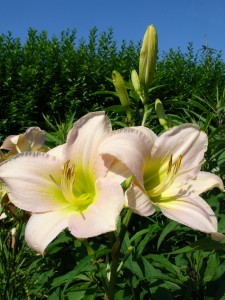 Hemerocallis, or Daylilies have been a garden staple for years. Their stunning trumpet-shaped flowers open and senesce within 24 hours, hence their name. The American Hemerocallis Society has over 48000 registered cultivars, and of the nearly 13000 of those are available commercially. That makes for a huge variety in color, height, bloom season, and flower form.
Hemerocallis, or Daylilies have been a garden staple for years. Their stunning trumpet-shaped flowers open and senesce within 24 hours, hence their name. The American Hemerocallis Society has over 48000 registered cultivars, and of the nearly 13000 of those are available commercially. That makes for a huge variety in color, height, bloom season, and flower form.
Daylilies will tolerate almost any soil type, and will perform in part shade to full sun. However, they prefer rich well drained soil. Full sun will guarantee the most blooms, and consistent water will help keep their foliage deep green throughout the growing season.
Maintenance is simple, yet can be time consuming, if you must take care of extensive plantings. Remove spent blossoms as they appear. Once all the buds have bloomed, cut the entire scape (flower stalk) down to ground level. As July turns to August, the foliage can begin to tatter and brown or many varieties. Remove brown, dry leaves as they appear, or cut the entire plant down to six inches and fresh foliage will soon replace it. An extra boost of fertilizer at this time will also help.
Daylilies mix very well in the border with nearly all summer flowering plants. For a long show of color, interplant Hemerocallis ‘Hyperion’ with daffodils, then follow up with the tender perennial Verbena bonariensis. Contrast large groups of daylilies with plants that have a different leaf form or flower color. Echinacea looks great next to daylilies, as does Phlox paniculata and Persicaria amplexicaulis ‘Firetail’. It’s really tough to go wrong!
The American Hemerocallis Society has a superb online database. Use it to chose plants that will bloom Early, Mid and Late season, and you can enjoy flowers all summer in a wide variety of colors and forms. http://www.daylilies.org/DaylilyDB/
